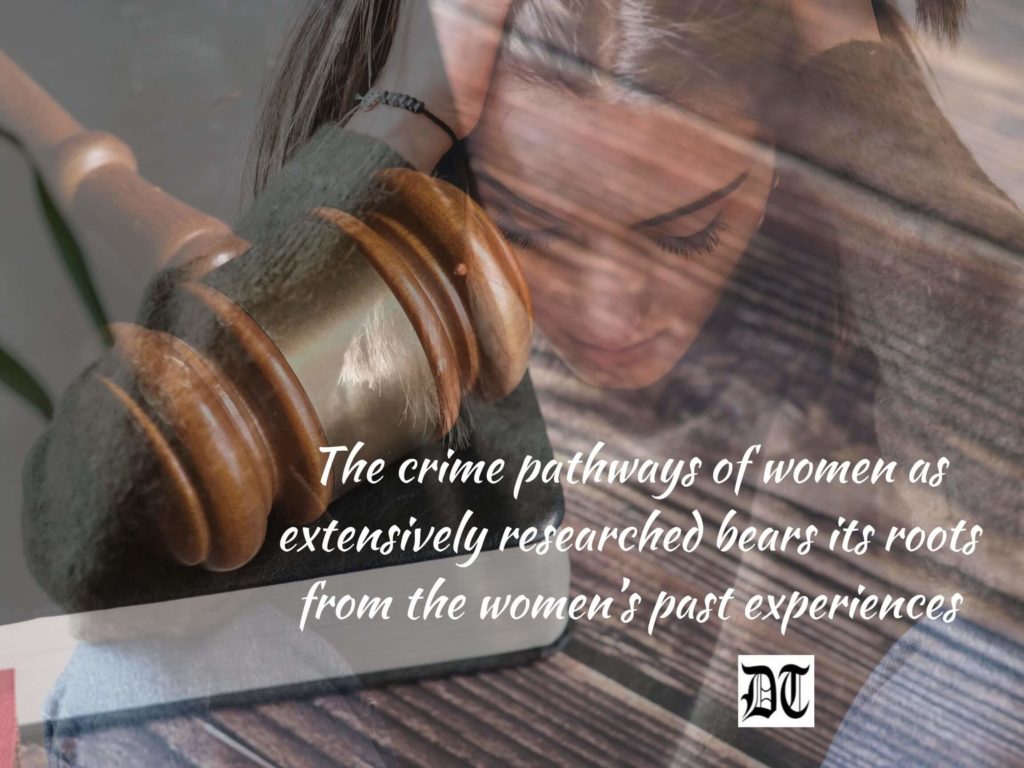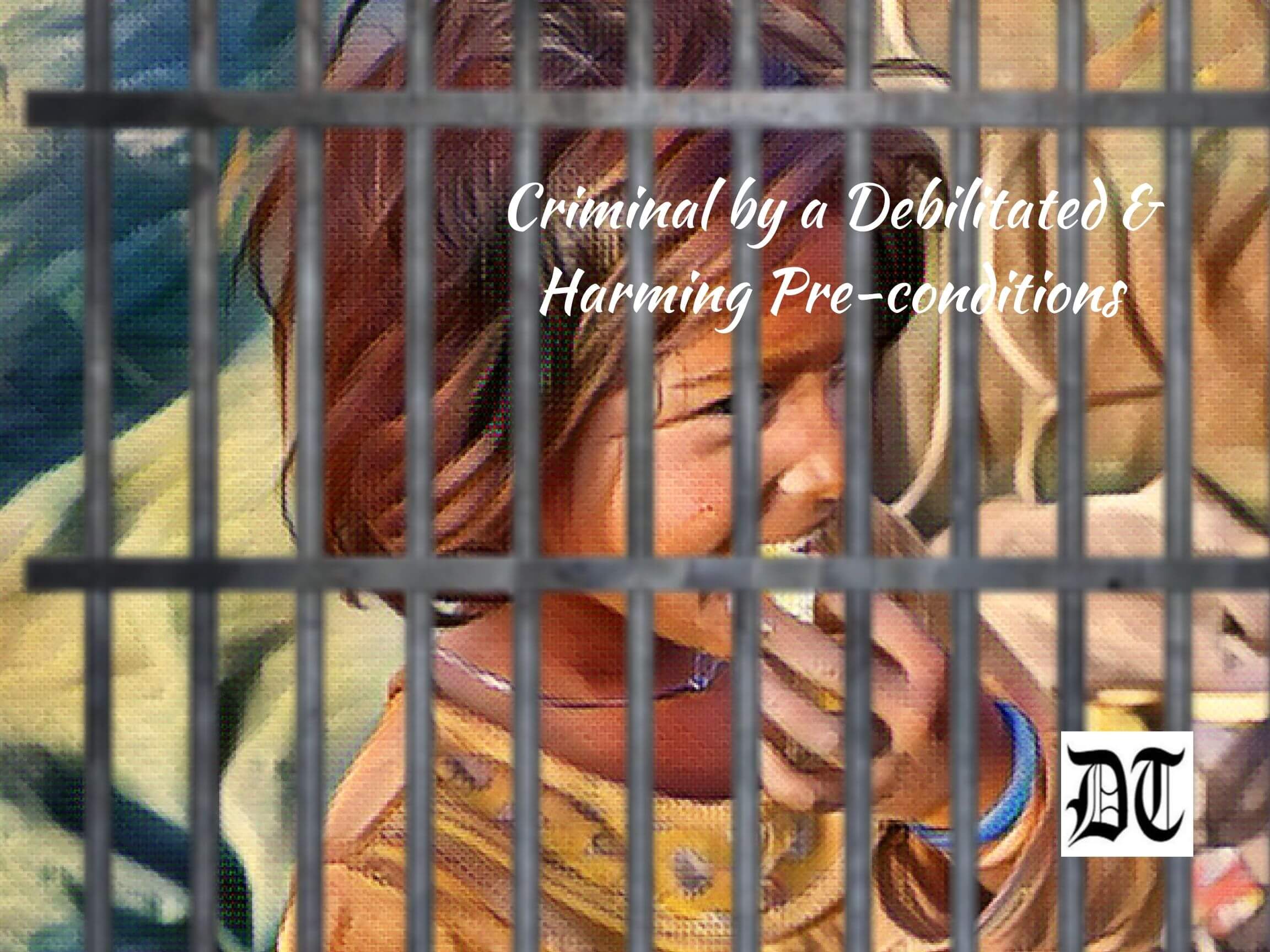Reading Time: 6 minutes
Dr. Tinku examines the pathways to crime of women in the context of feminist criminology. In her erudite paper, she argues that most women convicted as criminals are silent victims of a pathetic judicial system. An exclusive for Different Truths.
The Indian Brahmanical system social system is deep rooted in patriarchy, historically validated by the Hindu legal system embedded in Dharma or Nyaya. It provides a systematic and cogent collection of rules, covering all possible areas of social life. And hence forms an important and authoritative referral landmark in India’s legal history. Now, in this given structure of male biased control, the question of female criminality and imprisonment that have shown rising trends becomes an important issue for research.
In the State made frame when a woman commits a crime, she is deemed unfit for the society and its rules and dislocated in the prisons.
In the State made frame when a woman commits a crime, she is deemed unfit for the society and its rules and dislocated in the prisons. The aberrant and deviant behaviour woman undergoes meticulously through phases of languishing and slow-paced criminal justice system. It ends her life in jail sometimes as an under trial, without even terming her as a convict in the legal process.
John Rawl’s Theory of Justice develops a conception of justice from the perspective of this frame. People involved in it in order to execute their conceptions of the good life. Cooperation makes a better life possible for everyone by increasing the stock of what Rawls calls ‘primary goods’. The primary social goods include “rights, liberties, powers, opportunities, income, wealth, and the social bases of self-respect.” Their freedom consists in their possession of the two moral powers, “a capacity for a sense of justice and for a conception of the good.” (Rawls 1971). But women face incarceration differently and their pathways to prison are different. Against the conventional term used in feminist criminology, “pathways to crime”, I prefer to use “pathways to prison” acknowledging the driving factors.
Aarti, a 17-year-old girl daughter of Ram Murat belongs to a poor SC joint family and her father works as a mason. With five children in row to subsist, her parents toil hard to survive. Aarti had a very difficult childhood. She was often battered and tortured by her drunken father.
One day Aarti’s parents had a fight with a neighbouring family. Out of a fit of anger a lady slapped Aarti’s brother hard on his face. She got furious and silently carried the lady’s son, hardly four-year-old, to a nearby field where a lot of dry grass was laid to make a Machaan (a watch house made at a height).She tied the boy’s hands and strangulated him to death. Later, she ran back to her home panting to narrate the whole story to her family members, who then asked her to run away. She did the same and ran away from her home. For 24 hours she was absconding. And the police were trying hard to nab her. But the body was soon traced, and the boy’s dead body was recovered as some passersby noticed tiny legs peeping out of the covered grass. The local police on the tip given by locals and the family of the boy nabbed Aarti and put behind bars. Aarti has been convicted under 302 IPC.
At the time of committing the crime, Aarti was a juvenile and hardly had any idea of the gravity of crime she had committed.
At the time of committing the crime, Aarti was a juvenile and hardly had any idea of the gravity of crime she had committed. She is now 18 and has been housed with other hardcore female inmates in jail. Her trials are ongoing but it is needless to say that these trials are a uniform customary ritual followed religiously as a routine more than a judicial intervention. Nothing is heard and only thumb impressions are collected for records and the trials are over on paper. At times, it is the police officials who direct the prisoner to speak as directed. Therefore, it is only a one-sided affair.
Aarti has been renounced by her poor parents. For a few days, her father used to come to see her but then stopped. She does work for other inmates like washing clothes and cleaning for which she is given small tokens. Apart from this, she is sexually abused by a dominating inmate, who is also ill-famous hardcore criminal.
She is a silent victim posed as a criminal to society.
She is a silent victim posed as a criminal to society. There remains limited or no options for her when you have to stay in one barrack under one roof and for an un-predicted number of days. When asked what you do the whole day if you do not find interest in studies, she says shyly, “Sunita didi ka kaam karte hai”.
There is a visible hierarchy within the inmates. This hierarchy is not directly relational to the social and economic strata of the inmate but depends on the age, type of crime, attitude of the inmate etc.
Her case is in doldrums. Her parents produced her age certificate proving her as a juvenile at the time of crime committed. But it falls short of two months. But if the school administration takes interest and takes the matter as human error and revises the certificate she could be released. But because no personal interest of parents takes place the correct certificate is not produced in the court of law. She is registered as 18 years old at the time of crime. If proper advocacy is done she could be released. The jail authorities took personal interest and pursued her family (father) but he failed to contribute.

In this prototypical pathway, we locate the commitment of crime because of past life outcomes at various transition stages.
In this prototypical pathway, we locate the commitment of crime because of past life outcomes at various transition stages. These transitions could be from childhood to adulthood, adulthood to married life, etc. That is, the pre-conditions set in one’s life frames his/her life outcomes as consequences of the conditions. Thus, the aggressive, volatile nature of the person could be attributed to the self security mechanisms developed as a stimulus to outside hostile environments.
The crime pathways of women as extensively researched bears its roots from the women’s past experiences, at different stages of lifecycle. This could be childhood abuse or trauma where a conventionally understood safe and secure haven for a girl turns hell shaping and reshaping her attitude and outlook towards the outer world and society at large. These experiences could breed at adulthood with changing social ambience and exposures. Time and age form prime phases of women’s experiences that cultivate and nurture women’s life experiences that show reflections in their perceived notion and behavior towards the society.
The very positioning of a girl in an abusive or torturous childhood ambience … nurture her negative experiences of childhood …
The very positioning of a girl in an abusive or torturous childhood ambience and her relocation in her marital home or dislocation in an orphanage or shelter home may either nurture her negative experiences of childhood positively or even negatively further aggravating her deviation from normal course. This making of a ‘criminal women’, per se, could be very much in absence of her conscious level so that it could be checked. Thus, the outcome of such adversities is a ‘harmed and harming woman’.
These were women who had experienced neglect, physical and/or sexual abuse as children, and were branded violent or troublesome. Debilitated and harming women experienced a disordered home life and began using and abusing drugs and alcohol as a teen. Usually, these women reflected signs of emotional and psychological harm as adults and demonstrated an inability to cope with difficult situations. Therefore, due to hostility shown to her she becomes hostile in her behaviour and this behaviour becomes a routine nature of her life actions. When such actions go beyond the socially decided rules and laws she lands up in jail!
Thus, we need to understand the pathways to crime of women. We tend to assume them as criminals (or as crime doers). The practical experiences reveal that most of the women convicted as criminals are silent victims of the pathetic judicial system. They were in the trap of an indifferent judicial system and often battered by the police to forcefully admit to crimes even not committed. Many women were not even aware of their crime. They were somehow victims of conditions that were detrimental for them.
Picture design by Anumita Roy, Different Truths













